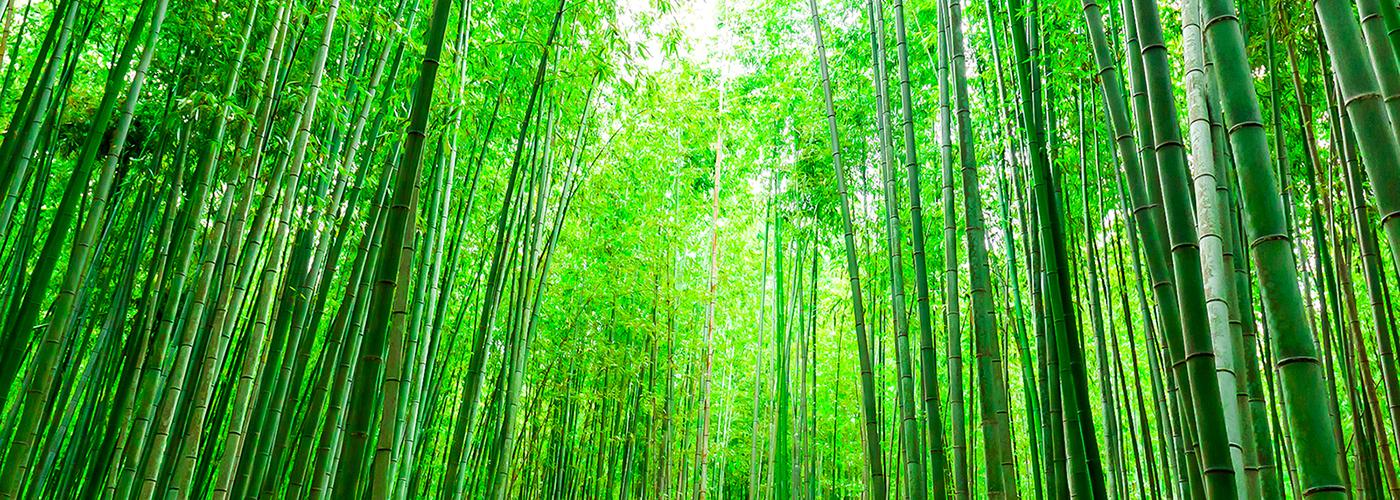- This month’s evergreen plant belongs to a grass family whose applications in the building industry are currently a hot topic due to their role in countering the effects of global warming.
- Bamboo canes are highly resistant, and bamboo itself is a focal point for environmental organisations due to its great capacity to store carbon and thus reduce CO2 emissions. But bamboo can not only help improve the health of the planet but also our own.
- Let’s look in more detail at what the favourite food of panda bears has to offer.

Bamboo, like corn and rice, is a plant from the Gramineae grass family. Although bamboo canes look similar to tree trunks, bamboo is in fact a type of grass. But not any type of grass, but rather a species with countless attributes. Let's see what makes bamboo so special.
Description
The word 'bamboo' comprises all herb species with long, cane-like structures, that can reach heights more characteristic of trees rather than herbs. According to the Bamboo American Society, there are around 500 different species in the Bambusae family, with one common feature to all of them being their arboriform structure, with woody, cane-shaped stems.
Bamboo is the fastest-growing and one of the most resilient plants on the planet.
It is divided into three main parts: the roots and rhizomes (an underground horizontal stem from which roots and stems sprout); the main stem, known as culm, a hollow, cylindrical cane that can reach up to 41 metres in height and 30 centimetres in diameter; and the leaves, which are the distinguishing feature between the different species. Bamboo's vegetative phase (when the stem is growing) lasts from three to four months, and its flowering phase can last between 30 and 120 years.
There are two highly valued assets of bamboo. The first is that bamboo canes are highly resistant, as strong as steel, this being the reason why bamboo is so desirable in the construction and furnishing industries. The second is that bamboo is one of the fastest-growing herbs on the planet, growing up to 91 centimetres per day. It is four times faster than eucalyptus trees. And most importantly, as it is a herb and not a tree, it can quickly regrow after cutting.
Origins
Bamboo is believed to originate from tropical and subtropical areas in Asia, Africa, Oceania, and America. Although it is not a native plant of Europe, nowadays it is also widely grown on this continent. An essential requirement for bamboo growing is a constant water supply during the growing phase. Bamboo adapts to different climates easily: from areas with temperatures of over 30°C, to high altitude zones with temperatures as low as -9°C, for instance in the Andes mountain range.
Applications
Bamboo and the building industry
Bamboo's great strength as a building material makes it a highly valued asset in the construction industry. INBAR, the International Bamboo and Rattan Organisation, includes 45 member states that promote environmentally sustainable development using bamboo. INBAR states that bamboo is a valid option for the building of housing, scaffolding, and furniture. It is a more ecological resource as it is capable of storing high amounts of carbon dioxide, thus contributing to the clearing of emissions of this gas which is heavily responsible for global warming.
As it is explained in the INBAR website, bamboo's yearly carbon sequestration can reach up to 25 tC/ha (tons of carbon per hectare) due to the fact that it's incredibly fast-growing. It can be harvested regularly to create a great range of durable products that can retain carbon for decades. This means that bamboo can capture more carbon than some tree plantations, storing from 200 up to almost 400 tC/ha, and this is why bamboo can play a key role in reforestation projects as well as in climate change programs.
Bamboo in the textile sector
Bamboo textile is made from the plant's cellulose. It needs a lower amount of water than other fabrics for its production, which makes it more sustainable, and it is biodegradable too. The resulting textiles are very porous, so they are great for wearing in hot climates.
Bamboo in the health sector
Rhizomes are the part of the bamboo plant that hold all the nutrients beneficial for humans. They are known gastronomically as bamboo shoots, and they contain the following elements:
- Fibre: bamboo's high-fibre content facilitates bowel function.
- Potassium: bamboo's high level of potassium helps reduce high blood pressure and contributes to maintaining the nervous system in good working order.
- Silicon: this compound helps keep bones healthy, and helps alleviate the hot flushes associated with the menopause.



Comments from our readers
There are no comments yet. Would you like to be the first?
Leave a comment!Did you like this post?
Your opinion about our seeds is very important to us and can help other users a lot (your email address won't be made public).